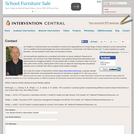
This classwide program can help to reduce noise levels and head off disruptive behaviors before they occur.
- Subject:
- Education
- Material Type:
- Teaching/Learning Strategy
- Provider:
- Intervention Central
- Author:
- Jim Wright
- Date Added:
- 02/10/2014

This classwide program can help to reduce noise levels and head off disruptive behaviors before they occur.
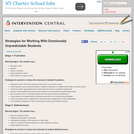
Some students are challenging due to internal frustration, defensiveness and aggression. This resource provides teachers with appropriate responses.

How do we define Public Art? This course focuses on the production of projects for public places. Public Art is a concept that is in constant discussion and revision, as much as the evolution and transformation of public spaces and cities are. Monuments are repositories of memory and historical presences with the expectation of being permanent. Public interventions are created not to impose and be temporary, but as forms intended to activate discourse and discussion. Considering the concept of a museum as a public device and how they are searching for new ways of avoiding generic identities, we will deal with the concept of the personal imaginary museum. It should be considered as a point of departure to propose a personal individual construction based on the concept of defining a personal imaginary museum - concept, program, collection, events, architecture, public diffusion, etc.
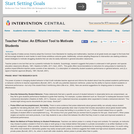
Teacher praise is one tool that can be a powerful motivator for students. Surprisingly, research suggests that praise is underused in both general- and special-education classrooms (Brophy, 1981; Hawkins & Heflin, 2011; Kern, 2007). This guide offers recommendations to instructors for using praise to maximize its positive impact.Effective teacher praise consists of two elements: (1) a description of noteworthy student academic performance or general behavior, and (2) a signal of teacher approval (Brophy, 1981; Burnett, 2001).
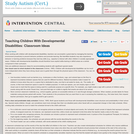
When working with children with developmental disabilities, teachers can accomplish a great deal by managing the learning environment proactively to prevent behavior problems and promote learning. But identified students may also experience behavior or learning problems because they lack key skills (e.g., capacity to interact with other children in socially appropriate ways). Children with developmental disabilities should therefore have explicit skills-training in deficit areas as a central component in their curriculum.
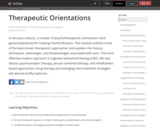
In the past century, a number of psychotherapeutic orientations have gained popularity for treating mental illnesses. This module outlines some of the best-known therapeutic approaches and explains the history, techniques, advantages, and disadvantages associated with each. The most effective modern approach is cognitive behavioral therapy (CBT). We also discuss psychoanalytic therapy, person-centered therapy, and mindfulness-based approaches. Drug therapy and emerging new treatment strategies will also be briefly explored.